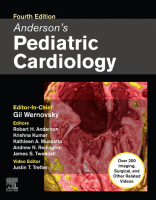Physical Address
304 North Cardinal St.
Dorchester Center, MA 02124

Introduction Noninvasive cardiovascular imaging plays a fundamental role in the clinical history of patients with congenital heart diseases (CHDs) and acquired cardiac conditions, from antenatal diagnosis to long-term follow-up in adult life. Prior to birth, different noninvasive imaging modalities are…

Introduction Appreciation of complex intracardiac anatomy and spatial relationships is inherent to the diagnosis of congenitally malformed hearts. Until recently, the ability of the clinician to image the heart by echocardiography was limited to two dimensions (2DE). The very nature…

Since the late 1970s, perhaps the most important change in the practice of clinical pediatric cardiology has been the introduction of cross-sectional echocardiography and its subsequent technical improvements. Echocardiography currently allows highly accurate diagnosis of nearly all morphologic abnormalities, for…

The practice of interventional cardiac catheterization consists of minimally invasive procedures where catheters are used to modify, palliate, or treat congenital or acquired cardiac disease. Evolution of interventional techniques has been a natural progression from open surgical procedures used to…

Introduction An understanding of the anatomy, physiology, and alternative treatment strategies for congenital heart defects is essential to provide the appropriate patient care. This includes an understanding of the guideline recommendations and the natural history of congenital heart defects. This…

Surgical Approaches to the Heart A variety of incisions are used in cardiac surgery. The majority of pediatric cardiac surgeries are performed through two incisions: the median sternotomy and the posterolateral thoracotomy. Other incisions are occasionally used to accommodate atypical…

On average, up to 12% of liveborn infants in the developed world are born prior to term. These rates have increased as a consequence of assisted reproductive technology and earlier intervention for either maternal or fetal well-being. The causes of…

In developed countries, the last few decades have heralded many advances in the diagnosis and management of congenital heart disease (CHD). These include surgery in neonates and infants; the establishment of pediatric cardiac intensive care; nursing and cardiac anesthesia; subspecialization…

Introduction Examination of the frequency of congenital cardiac disease, either as a rate or as a proportion, has important implications for the study of congenital cardiac malformations, as well as their clinical management. However, there is much confusion and misuse…

Support of the pregnant mother and her partner is a critical element in the diagnosis and management of congenital heart disease (CHD) in the fetus. From the moment a woman/couple are identified as possibly having a fetus with CHD, to…